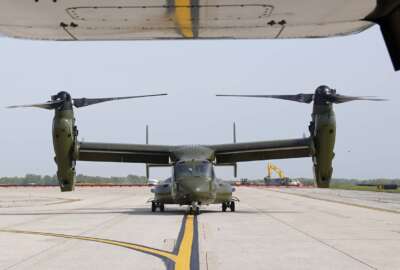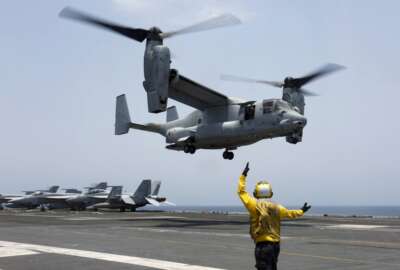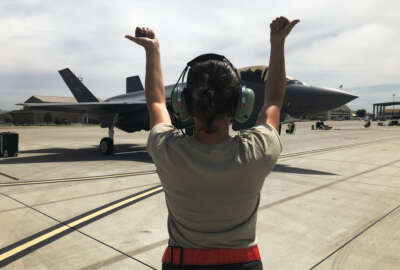The V-22 — a Marine Corps aircraft that keeps on killing Marines
The Marine Corps has been operating the V-22 transport aircraft for more than 30 years. But it has continued to deal with crashes.
The Marine Corps has been operating the V-22 transport aircraft for more than 30 years. And for more than 30 years, the Marines have been dealing with crashes. Sometimes deadly ones. The vertical lift machine has killed 60 people. The cycle of accidents, groundings, and returns to flight continues to this day. Brad Dress, a reporter for The Hill, did a detailed analysis of the data connected to the V-22. He joined the Federal Drive with Tom Temin to discuss.
Interview transcript:
Tom Temin: And what prompted this look at the V-22 in such detail? I mean, has the Pentagon looked at it enough already?
Brad Dress: Yeah, there’s been a long history with this aircraft. The military really values it. It’s a hybrid aircraft called a tiltrotor. It takes off like a helicopter and can fly like a plane. So the military is always sort of seeing this as valuable for flying in unique missions. But it has a long and troubled history of crashing. And even before when it was being developed, there was a lot of problems with the development and with the cost of the aircraft. But as soon as they debuted in early 1990, it crashed and it’s continuing to crash. And it’s led to a lot of concerns from service members and families of victims of service members who died in some of these crashes. So it really is something that remains unresolved and they’re still trying to understand exactly why it keeps crashing.
Tom Temin: And it sounds like there’s a treasure trove of research and data and so forth connected with this particular crash propensity of this plane, this transport?
Brad Dress: Yeah. So what I did, I looked at some of the history of this aircraft and some of the data behind the crashes, including crash rate data, which really points to the fact that the aircraft has crashed a bit more than other similar aircraft, like large helicopter, like the Chinook or the Black Hawk. So there are different factors you can look at and filter through. But the Air Force has this data on their website and it does show that the Class A mishap rating, which are like severe accidents, are generally higher for the Osprey and the Osprey actually has less flight offers than some of these other aircraft. So when you start comparing these data, you do see that there is a troubling history here. The data alone is not conclusive, though, and there definitely needs to be a lot more research done, I think, in this space to really understand because I still think a lot of people are, they not know exactly why it’s crashing and is there something that can be done to stop these crashes they don’t know. So there’s still a lot that they’re trying to understand here.
Tom Temin: And you found that there is no one single cause that would kind of make it simple, I guess, if they knew exactly why these things crash. But there’s a multiple reasons, correct?
Brad Dress: Yes, that’s correct. I looked at this pattern of crashes and there’s multiple different problems that have come up throughout the years. I think the biggest one is hard clutch engagement. It’s when the clutch disengages and then reengages. That’s been something that they’ve been studying for the past few years or longer because they’ve identified that as a problem in several of these crashes, including a 2022 crash in California that was listed as the primary reason for that crash and actually spoke with family members of some of the Marines who died in that crash. And some of those family members have filed a lawsuit against the manufacturers and the Osprey that includes Boeing and Bell Textron and Rolls-Royce, which makes the engines. And they say that there’s been known problems with this aircraft that just haven’t been resolved. And specifically with the clutch problem, later this year, in the spring of this year, we’re going to see they’ve identified parts they’re going to be fixing that may solve this.
Tom Temin: Sure.
Brad Dress: HCE, hard clutch engagement problem. So part of the lawsuit is like, ‘Well, how long have they known about that and could this fix have been adopted sooner?’
Tom Temin: We’re speaking with Brad Dress. He’s a reporter for The Hill. And this clutch issue is that when it goes from vertical to horizontal flight, is that one that problem occurs?
Brad Dress: It’s essentially when it’s switching power over between the engines. So it’s really complex to get into. But when you engage, the clutch is supposed to be switching power. There are two engines that are working in the aircraft and sometimes one of them fails. The clutch should be switching to the other engine. In many cases we’re seeing, that’s not happening.
Tom Temin: So engine failure then, besides the clutch, would seem to be an issue if they constantly have an engine going out.
Brad Dress: Yeah. They haven’t identified exactly why there’s been engine failure in some of these cases. There’s been a range of different reasons in the past. Some of them have been like pilot error, at least that’s what the mishap reports have identified or there’s something physically happening to some visual collision or something of that sort that’s been affecting the aircraft. But in any sense, the clutch problem is not working as intended. And they’ve also identified that a lot of these parts are supply chain issues, a lot of these parts, and some of them are like failing or there like weak or much weaker than they should be. So that includes these metal alloys from a company called Universal Stainless. And so they don’t know. They’re still trying to study exactly why some of these parts are failing. But it is at least something that has been identified in the past as another issue.
Tom Temin: And it’s difficult to get along without them. There’s several hundred of them in the fleet and it’s central to their operations, fair to say?
Brad Dress: Yes. The Marines really highly value this. It’s not just flown by the Marines. It’s also flown by the Air Force, the special operations and also the Navy. So there’s a lot of these Ospreys out there. And despite all these concerns, including the last deadly crash was November 2023 near Japan, which killed eight airmen. That went to a grounding of the fleet, but only temporarily. Now, they’ve lifted that again and we expect that they’ll be flying this in full force by the spring of 2025. So they’ve acknowledged some of the problems with the Osprey, but the Marines in particular have been very defensive of the aircraft.
Copyright © 2025 Federal News Network. All rights reserved. This website is not intended for users located within the European Economic Area.
Tom Temin is host of the Federal Drive and has been providing insight on federal technology and management issues for more than 30 years.
Follow @tteminWFED







